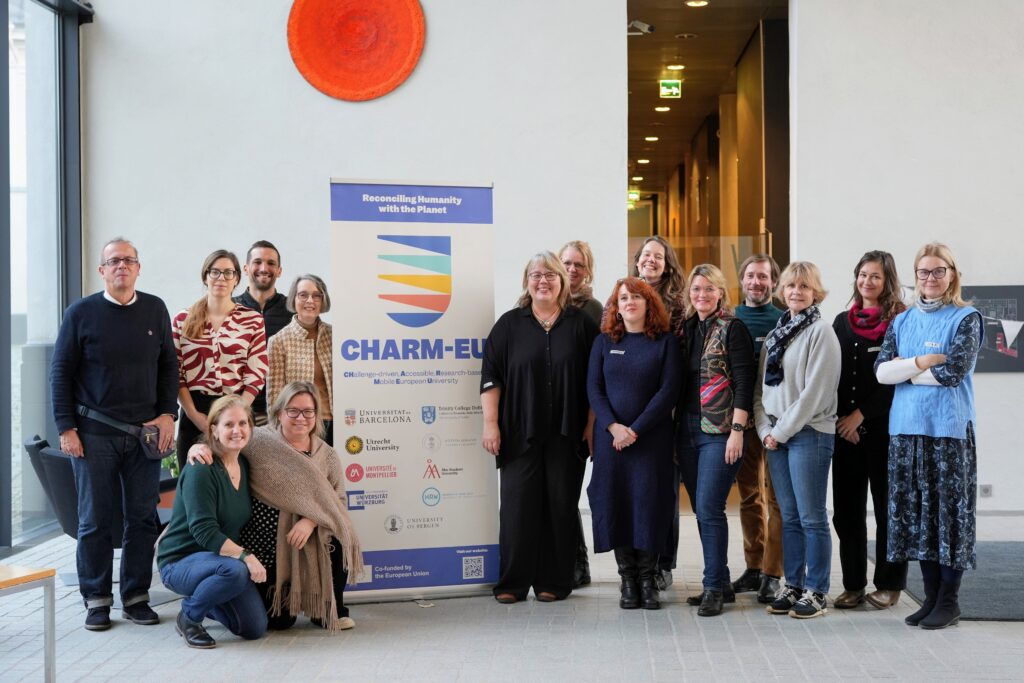Innovative international mobility for a more inclusive and engaging learning experience
Blended Intensive Programs (BIPs) redefine international mobility by combining short-term physical exchanges with virtual collaboration. This innovative Erasmus+ initiative offers students and staff a flexible and inclusive way to engage in international learning while ensuring accessibility for those who may face challenges with long-term mobility. By integrating both virtual and in-person components, BIPs facilitate meaningful academic and professional interactions, enhancing digital skills, employability and intercultural collaboration. They provide a structured approach to international experiences and contribute to the broader goal of increasing mobility participation across higher education institutions.
Read more
Blended Intensive Programs (BIPs) are a core component of the Erasmus+ 2021-2027 framework, designed to modernize and expand international mobility opportunities. They are developed and implemented by a minimum of three universities from different Erasmus program member countries, integrating virtual learning with physical mobility that lasts between 5 and 30 days. This dual-format structure ensures academic continuity, maximizes engagement and allows for greater participation, particularly among students and staff who may face barriers to traditional mobility programs.
Beyond the student experience, BIPs create institutional value by fostering inter-university collaboration, strengthening research networks and contributing to the European Commission’s goal of achieving a 50% student mobility rate by 2030. For faculty and administrative staff, they provide opportunities for pedagogical innovation and professional development.
BIPs benefit various stakeholder groups, including students, academic staff and institutions, by promoting international collaboration, enriching academic programs and fostering the development of professional skills.
For students, BIPs offer the chance to participate in short-term international exchanges that combine virtual learning with immersive on-site experiences. These programs allow students to broaden their academic horizons, develop essential intercultural and digital competencies, and build global professional networks. The combination of virtual and physical elements makes these programs more accessible to a wider range of students, particularly those with constraints that might prevent them from engaging in traditional long-term mobility options.
For academic staff, BIPs provide a platform for experimenting with new teaching methods, collaborative course design and transdisciplinary education. Educators benefit from knowledge exchange, exposure to diverse teaching environments and participation in transnational academic communities.
For institutions, BIPs contribute to curriculum innovation, fostering interdisciplinary collaboration and strengthening ties with international partners. The integration of blended mobility into structured programs supports internationalization at home while offering institutions a framework for developing inclusive policies that align with Erasmus+ priorities. Furthermore, BIPs support the development of inclusive strategies that ensure mobility opportunities are available to a broader range of participants.
For CHARM-EU, BIPs play a significant role in enhancing mobility within its Master in Global Challenges for Sustainability (MGCS) program. Since the launch of the MGCS program, several BIPs have been successfully implemented, focusing on themes such as sustainability, global challenges and interdisciplinary cooperation. These programs not only enhance academic learning but also provide a platform for institutional collaboration, paving the way for future joint initiatives and expanding the scope of international mobility. For a detailed overview of the implemented BIPs within the program, refer to the Mobility Handbook.
Further resources
SOMETHING FOR YOU TOO? EXPLORE THE OPPORTUNITIES!
The Blended Intensive Program (BIP) offers a unique opportunity for academic staff to engage in cross-institutional collaboration, fostering student mobility through a combination of virtual and physical activities. Each BIP follows a structured process, beginning with curriculum alignment, consortium formation and funding allocation, followed by student selection, academic preparation and program delivery. If you are an academic staff member interested in implementing a BIP or an institutional coordinator seeking to enhance your mobility offerings, learn more about how you can get involved in the BIP initiative below.
WOULD YOU LIKE TO CARRY OUT A SIMILAR PROCESS YOURSELF? SEE OUR GUIDES!
| Step | Action | Who Should Be Involved? | Resources / Support |
| Step 1 | Learn about BIPs Familiarize yourself with Blended Intensive Programs (BIPs), including their purpose and benefits for students and institutions. | International coordinators, academic staff, department heads and administrative units | Mobility Handbook European Commission: Erasmus + Programme Guide 2024 European Commission: Higher Education Mobility Handbook European Commission: Blended mobility implementation guide for Erasmus+ higher education mobility KA131 EAIE Blog: 5 tips for running Erasmus+ Blended Intensive Programmes |
| Step 2 | Assess institutional readiness and identify opportunities Begin by reviewing the curriculum of your institution and identifying potential modules or courses where a BIP can be integrated. Evaluate institutional capacity to host BIPs, including faculty availability, technological readiness and student demand. | International coordinators, academic staff, department heads and administrative units | |
| Step 3 | Promote BIP opportunities Promote the identified BIP opportunities through official communication platforms, departmental meetings, and academic networks. Engage both faculty and students to gauge interest and ensure alignment with their academic and professional goals. | International coordinators, academic staff, department heads and student advisors | CHARM-EU Website News and events page |
| Step 4 | Identify potential BIP partners Start exploring potential partner universities within the CHARM-EU network to collaborate on BIPs. Evaluate which universities would be the best fit for joint programs and ensure compatibility in terms of academic focus, course offerings and logistical support. | International coordinators, academic department heads, academic staff | CHARM-EU members Support Contacts |
| Step 5 | Prepare and submit Erasmus+ application for BIPs Once potential partners and resources are confirmed, prepare your Erasmus+ application for BIP funding including a clear budget plan. Make sure to plan for the number of outgoing students and allocate funds for mobility grants and administrative costs. Coordinate with partner universities to ensure alignment in funding allocations and administrative responsibilities. Ensure that the application aligns with Erasmus+ guidelines. Include detailed descriptions of the BIP’s academic content, partner contributions and expected outcomes. | International coordinators, academic staff, international offices, financial officers, partner universities | European Commission: Blended mobility implementation guide for Erasmus+ higher education mobility KA131 CHARM-EU members Support Contacts |
| Step 6 | Design the curriculum and virtual component Collaborate with your partners to co-design the BIP curriculum. Establish learning outcomes, assessment methods and teaching strategies for both the virtual and in-person components. | International coordinators, academic staff, department heads, partner universities | CHARM-EU members Support Contacts |
| Step 6 | Ensure credit recognition and grading Confirm that credits earned during the BIP will be recognized by the institution. Define grading systems for both virtual and in-person components. | Faculty members, international coordinators, academic departments | |
| Step 7 | Announce and select participants Announce the call for student applications and specify eligibility, credit recognition and program details. Guide students in finalizing their learning agreements. | International coordinators, academic staff, department heads and student advisors | CHARM-EU Website News and events page |
| Step 8 | Facilitate the BIP implementation and monitor progress Implement the program, ensuring that the virtual component (online collaboration, preparatory activities, or follow-up tasks) is well-integrated with the in-person mobility experience. Monitor students’ participation and progress throughout the program. Provide support for both academic and logistical issues during the BIP. | International coordinators, academic staff, international offices, BIP coordinators | |
| Step 9 | Assess and provide feedback Upon completion of the BIP, gather feedback from students and faculty on the overall experience, including academic satisfaction, logistical support, and cultural immersion. Analyze this feedback to identify areas for improvement for future BIPs. Provide students with their final grades and ensure that all credits are properly recorded in the Transcript of Records (ToR). | International coordinators, academic staff, international offices, BIP coordinators |

